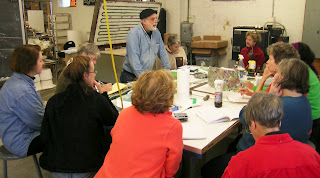George Washington FUN FACTS
--Admiring biographers make much of the fact that Washington turned down a salary from the Continental Congress and asked instead that he be paid only for his expenses as commander-in-chief. As it turns out, the general made a sound financial decision. If he had accepted the salary ($500 a month) he would have received a total of $48,00 for his service. As it was, his expense account during 8 years of war came to $447,220, according to the smallest estimate. Included in this total were sums for a new carriage, expensive saddles, and imported wines for his headquarters.
--When the capital was moved from New York to Philadelphia, Washington, who had been disappointed in the food that he had been eating as President, brought his black slave Hercules from Mount Vernon to serve as cook. Pennsylvania law provided that slaves be given their freedom after 6 months' residence in the State. To avoid the possibility of losing the services of his master chef, Washington would send Hercules back to Mount Vernon just before the 6 months were up. Then, several weeks later, he would have him returned to the capital. Hercules, who soon won a reputation in Philadelphia as a flashy and colorful dresser, was much too smart to stand this arrangement for long. One night before the end of Washington's term he disappeared and much to the President's disappointment was never heard from again.
--One of the most seriously misleading of the Washington legends is the story of the pious general kneeling in prayer in the snow at Valley Forge. Not only is there no evidence to support this tale, but Washington was notorious in his parish church for his refusal to kneel at any of the customary moments in the Episcopal service. As his minister declared disapprovingly after the President's death, "Washington was a Deist." Although Martha was a devout churchwoman, George never shared her enthusiasm. On communion Sundays he always walked out before taking the eucharist, leaving Martha to participate in the service alone.

In 1842, Abe was challenged to a duel. Abe won. Abraham Lincoln FUN FACTS
--Lincoln was never associated with any organized church, and as a young man in New Salem he had a reputation as an outspoken nonbeliever. Having read Thomas Paine, he liked to argue with friends against the tenets of conventional religion. In his 1846 congressional campaign, Lincoln's unorthodox position became a campaign issue, and he offered the only public statement of his career on his religious convictions: That I am not a member of any Christian Church, is true; but I have never denied the truth of the Scriptures; and I have never spoken with intentional disrespect of religion in general or of any denomination of Christians in particular.
--In 1842, Lincoln accepted a challenge to a duel from James Shields, the Democratic State auditor. Shields was furious over a satiric letter in a local paper. Actually, the letter had been written by Lincoln's fiancée, Mary Todd, but Lincoln willingly took responsibility. Since he was given the choice of weapons, Lincoln, with typical cunning, selected broadswords--with his 6'4" frame and his enormous arms, Lincoln had an insurmountable advantage over his diminutive opponent when it came to dueling with swords. Shields wisely decided to make up his differences with Lincoln and the scheduled duel failed to take place.
--The clutter in Lincoln's law office was notorious, and a continual source of irritation to his partner, William Herndon. On his desk, Lincoln kept one envelope marked "When you can't find it anywhere else, look into this."
--Frederick Douglass, the celebrated black abolitionist and former slave, was invited by Lincoln to the inaugural reception in 1865, but when Douglass tried to enter, policemen man-handled him and forced him back out. Making his way in again, he managed to catch Lincoln's eye. "Here comes my friend Douglass," the President exclaimed, and, leaving his circle of guests, he took Douglass by the hand and began to chat with him.
--Once, shortly before his election to the Presidency, Lincoln reported that he was startled by a vision. As he lay down to rest, weary over a hard day of politics, he caught a glimpse of his face in a mirror--and was startled to see a double image of himself. The 2nd image in the mirror was pale, "like a dead man's." After a few days, when the same pair of images reappeared, he discussed the phenomenon with his wife. She interpreted it to mean that Lincoln would be elected to 2 terms as President, but that he would die during his 2nd term.
Presidential trivia facts from: www.trivia-library.com
 The New Materiality: Digital Dialogues at the Boundaries of Contemporary Craft is an exhibition that Fo Wilson had curated originally for the Fuller Craft Museum in Massachusetts in 2010. It has started a national tour and was on view at the Milwaukee Art Museum and the Asheville Museum in North Carolina. This April it will also travel to the Arkansas Art Center, opening April 13, 2012.
The New Materiality: Digital Dialogues at the Boundaries of Contemporary Craft is an exhibition that Fo Wilson had curated originally for the Fuller Craft Museum in Massachusetts in 2010. It has started a national tour and was on view at the Milwaukee Art Museum and the Asheville Museum in North Carolina. This April it will also travel to the Arkansas Art Center, opening April 13, 2012.











































